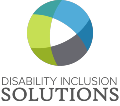If you’re looking to attract the greatest pool of people with disabilities, you need to implement universal design strategies. Disability Inclusion Solutions teamed up with Progressive AE to assist companies in creating an inclusive environment where every employee can be successful. Learn what steps you can take to make that happen.
Captioned video:
Video transcript:
ANDREW HOUGHTON: I’m sure you’re thinking, you know, how am I going to get beyond the ADA and attract the greatest pool of individuals with disabilities and others that I can?
Well, one way to do that is through universal design and implementing those strategies. You need to get beyond the ADA. The ADA is the baseline. Universal design is the future.
Disability Inclusion Solutions is a certified disability-owned business through Disability In.
MIKE PERRY: Hi, I’m Mike Perry. I’m an architect. I also lead the universal design consulting practice at Progressive AE. Progressive AE is a full-service architectural engineering firm and I had the pleasure of working with Andy for the last three years. He is really making a difference when it comes to helping companies on a global scale implement universal design practices.
ANDREW HOUGHTON: When Mike and I go visit a facility, we’re looking at the entire site. We start with the exterior. We’re looking at everything from entryways to restrooms. We’re looking at conference rooms, access around the conference room to ensure that there is enough room for individuals to you know, get around the entire table.
We’re also looking at the furniture. You know, furniture in conference rooms, there is typically a receptacle in the middle of the table. We want to make sure that it is accessible, it is within reach. Is it recessed or is it pop up? We’re looking at the wayfinding. How do you maneuver throughout the building? Is there clear distinguishing characteristics on the flooring that you know, will help individuals with low vision and even individuals who may be looking down on their devices as they’re walking. We want to reduce risk.
MIKE PERRY: So, we put together a universal design checklist and it is based on really a couple key principles. One is it breaks a facility and a campus up into different areas and then the key question we always ask ourselves is what can a user expect when they enter a building, when they enter a site, when they use an auditorium?
The checklist is quite extensive. In the end, what we do to help clients is we boil it down to a couple of different priorities, P1 priorities and P2 priorities.
P1 priorities are really the areas we’re going to focus on as the recommendations because those are priorities that we believe can be done at no or low cost with the highest impact to the users of the facility.
ANDREW HOUGHTON: I really appreciate the opportunity to share a little bit about the work that we do around universal design and we have the capabilities to help you achieve success in this area.





0 Comments